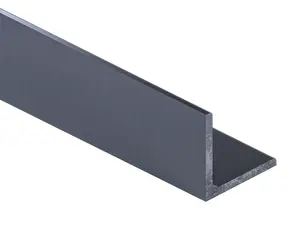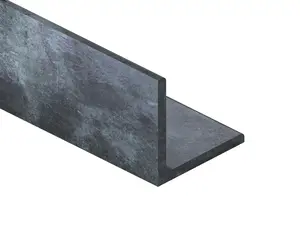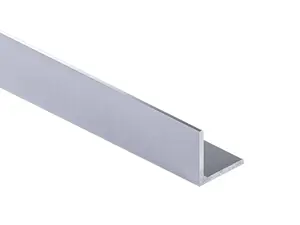One of the most versatile structural components is steel angle brackets. These components, indispensable in many projects, are the basis for a wide range of applications - from small furniture components to architectural structures and large-scale buildings.
Characteristics of angle bars
Steel angle is a unique closed profile, which is distinguished by its specific L-shaped structure. It is characterized by two wings, which are set at right angles to each other. Steel angles are manufactured from different types of steel and have a wide range of sizes, depending on their applications.
There are two main types of steel angles on the market: hot-rolled angle and cold-formed angle. A properly selected production process affects the mechanical properties and dimensional accuracy of the final product.
Hot-rolledangle bars are produced by hot rolling of steel. The process begins by heating the steel charge to the appropriate high temperature, and then goes through a series of rollers that gradually shape the material into the desired form. The hot rolling process results in products with a more homogeneous grain structure and better ductility. In addition, hot-rolled angles have a smooth surface that is free of any distortion or sharp edges, making them more aesthetically pleasing.
The differences between hot-rolled and cold-formed angle sections are noticeable both in the manufacturing process and in the properties of the finished product. Unlike cold-formed angle iron, which is formed at lower temperatures and can present signs of distortion or sharp edges, hot-formed angle iron is more resistant to external actions and has a better ability to conduct loads. These properties make it the preferred choice for many structural and engineering projects.
Features and advantages of angle bars
Features of hot-rolled angle bars:
- Smooth surface - no sharp edges or distortion typical of cold-formed angle bars.
- High ductility - ability to deform under load without cracking or damage.
- Dimensional precision - excellent dimensional accuracy, ensuring consistency and precision in installation.
- Corrosion resistance - the hot-rolling process often results in the formation of a protective oxide layer on the surface, which further increases corrosion resistance.
Advantages of hot-rolled angle bars:
- Higher strength - due to their homogeneous grain structure, these angles have better mechanical properties compared to their cold-rolled counterparts.
- Better load-carrying capacity - thanks to their uniformity and dimensional precision, these angles are ideal for structural applications with high load requirements.
- Reduced risk of damage during installation - their high ductility and dimensional accuracy minimize the risk of damage during machining or installation.
Steel grades
We offer hollow angles made of S235JR (1.0038) and S355J2 (1.0577) steel.
S235JR steel (1.0038)
Features:
- Chemical composition - non-alloy steel with low carbon content.
- Yield strength - about 235 MPa.
- Applications - most often used in general construction, where high mechanical properties are not required.
Advantages:
- Good weldability - S235JR steel is easy to weld due to its chemical composition.
- Good machinability - it can be easily machined, making it versatile in its range of applications.
- Cost - it is a relatively inexpensive material compared to steels with higher mechanical properties.
Disadvantages:
- Limited strength - compared to higher grades, S235JR steel has lower strength and hardness.
- Limited applications in demanding conditions - due to its lower strength, it is not suitable for structures subjected to high dynamic loads or impacts.
S355J2 steel (1.0577)
Features:
- Chemical composition - non-alloy steel with the addition of carbon, manganese and silicon.
- Yield strength - about 355 MPa.
- Applications - used in load-bearing structures and machinery where greater strength is required.
Advantages:
- Higher strength - compared to S235JR, this steel has better mechanical properties, allowing it to be used in more demanding applications.
- Good weldability - despite its higher mechanical properties, S355J2 still offers good weldability.
- Impact resistance - S355J2 is more resistant to impacts and dynamic loads than lower grades of steel.
Disadvantages:
- Cost - compared to S235JR, this steel is more expensive due to its better mechanical properties.
Angle steel applications
Steel angle is a versatile structural element that is used in many industries and engineering projects. Thanks to their L-shaped shape, steel angles provide support and reinforcement where it is needed most. Steel angles are used in construction, both civil and industrial, as key components in frame structures, masts, towers or curtain walls.
Hot-rolled angles are often chosen in situations where higher precision, aesthetics and material uniformity are required. Hot-rolled steel angle is ideal for applications where better corrosion resistance and greater strength are required. Such angles are often used in steel structures with a high degree of complexity, where installation precision and durability of connections are crucial.
Advice for investors
- Determine the purpose of the angle bar - consider whether the angle bar will serve a structural function, a decorative function, or both. Choosing the right material and type of angle bar depends on its purpose.
- Find the right steel - if you have decided on a steel angle bar, identify the grade of steel needed depending on the strength requirements.
- Pay attention to dimensions - make sure that the angle brackets you choose have the right dimensions for your project. Think about length, width and wall thickness.
- Consult an expert - if you have doubts about choosing the right angle iron, consult a steel construction expert or material engineer.
- Take care of material availability - if you are planning expansion or further developments, it is worth buying a little more angle iron than you currently need to ensure continuity of supply and material uniformity in future projects.
Storage of angle bars
Proper storage of steel angle brackets is key to maintaining their quality and functionality. Our recommendations:
- Horizontal storage - angle irons should be stored horizontally on stable and level supports to prevent bending or distortion.
- Spacing of supports - the supports on which the angles rest should be evenly spaced to ensure even weight distribution.
- Protection from moisture - storing angle brackets in a dry and well-ventilated place reduces the risk of corrosion.
- Clearance from the floor - angle irons should be stored at least 10 cm above floor level to avoid direct contact with moisture.
- Accessibility - make sure access paths to angle irons are always clear for easy retrieval and movement.
- Protection from the elements - if storage is outdoors, stacks of angle iron should be shielded from rain, snow or other weather conditions with tarps or other protective materials.
Did you know
- The first angle irons were used as early as in antiquity. Civilizations of the time, such as Egypt and Rome, used them in construction, using stone or wood, before technology made it possible to manufacture steel angles.
- Angles are not only used for construction. In scientific laboratories, angle irons made of precision materials can be used to assemble test apparatus and ensure precise alignment of equipment.
- In addition to traditional engineering uses, angle irons are sometimes used in contemporary art as elements of sculptures and installations.
- The process of making angle irons is constantly evolving. From hand forging in ancient times, through traditional blacksmithing techniques, to modern rolling and CNC machining technologies today.
Angles - why with us?
At Moris steel wholesaler, we offer a wide selection of angle irons of the highest quality to suit a variety of requirements. Our professional staff guarantees expert advice and support at every stage of your order. Thanks to flexible delivery methods, we are able to deliver the product exactly where it is needed, always on time.
We offer hot-rolled angle bars, which are widely appreciated for their strength, resistance to deformation, as well as ease of installation. Steel angle brackets from our offer are a guarantee of solidity and durability of any structure.
We invite you to familiarize yourself with our offer and choose the steel angle bars that will best meet your expectations.
FAQ
What does an angle bar look like?
An angle bar is a type of metal profile, which has an L-shape seen in cross-section. It consists of two arms that meet at right angles. The arms of an angle bar can be of equal or different lengths, depending on the specific requirements of the application. Angles are available in a variety of sizes and thicknesses to suit specific project needs.



